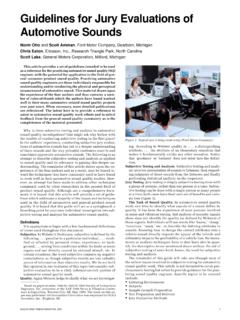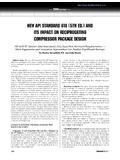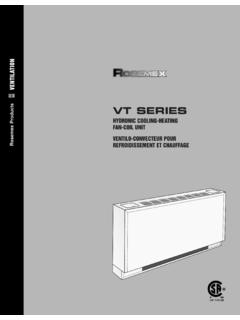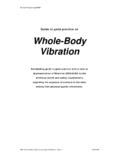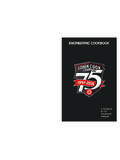Transcription of HID Inspection Guide Offshore - HSE: Information about ...
1 HID Inspection Guide Offshore Inspection of noise and vibration Contents Summary Introduction Action Background Organisation Targeting Resources Recording & Reporting Appendix 1: Noise Appendix 2: Hand Arm vibration Appendix 3: Performance Monitoring Summary This guidance outlines an approach to Inspection of dutyholder's arrangements for managing health risks Offshore associated with Noise and Hand-arm vibration . It also sets out criteria for satisfactory and unsatisfactory performance factors against which the duty holder performance will be rated for each of these areas. References are made to technical standards and guidance that inspectors will use to form opinion for legal compliance. The effectiveness of such systems is a key component of occupational health risk management and securing effective control of health risks to prevent or minimise the incidence of occupational diseases such as noise induced hearing loss, hand arm vibration syndrome.
2 Introduction The aim of this Operational Guide (OG) is to provide Information and guidance to Offshore inspectors to support the delivery of consistent and effective health risk management. It does this by highlighting current key areas to be covered during inspections, providing a framework for inspectors to judge compliance, assign performance ratings, and decide what enforcement action to take should they find legislative breaches. In doing so, it complements HSE's Enforcement Policy Statement (EPS) and Enforcement Management Model (EMM). The operational guidance outlines HSE's priorities for Inspection of Noise and Hand-arm vibration health risks Offshore . It is important to note that this guidance does not include detailed Information on other Offshore health risks such as Hazardous Substances, Asbestos, Ergonomics/manual handling, Ionising and Non-ionising Radiations, Thermal Page 1 of 11.
3 Environment, Personal Protective Equipment, Food/Water hygiene, First-Aid and Welfare, which continue to form part of the remit of the Offshore Occupational Health Team ( ). Action Inspection of this topic should include both Inspection of the priority areas as well as an Inspection of the overall policy, procedures and organisation for managing occupational health risks to establish a consistent and complete coverage of the topic. In inspecting individual topic areas it may be necessary to have input from the relevant specialist inspectors where there are technical issues beyond the competence of the IMT. inspector. Success criteria are listed under the Inspection topics (see appendices); these cover the key issues that inspectors should consider when carrying-out inspections against each core intervention issue.
4 In some instances, not all of the success criteria will apply so inspectors should make a judgement regarding which of these are relevant in each case. If the relevant success criteria cannot be met, inspectors should assess how serious the consequences of failure to comply could be. This will inform their decision making in terms of the performance ratings that they assign and the enforcement action they take (if any) based on the findings of the Inspection . The Offshore Occupational Health Team ( ) should be consulted where formal enforcement action is being considered. When carrying out inspections covered by this guidance inspectors should: check the key issues against their success criteria in Appendices 1 . use the generic performance descriptors in Appendix 3 to: o determine the appropriate performance rating; and o the initial enforcement expectation to use alongside the EMM.
5 Consider how and when the issues raised during an Inspection are to be closed out and recorded using the COIN issues tab;. Where other occupational health, safety and welfare concerns are encountered during an Inspection , deal with such issues as a matter of routine and apply existing standards to determine what action to take in each case according to HSE's Enforcement Policy and EMM. Background The aim of Occupational Health is to prevent or control exposure to health risks by recognising health hazards, evaluating the risk and establishing appropriate control measures. The occupational health hazards may include Physical agents ( noise, vibration , radiation). Hazardous substances ( chemicals, asbestos). Biological agents ( Legionella, food hygiene). Ergonomics/manual handling The essential requirements for managing occupational health are the same as those for any management system.
6 Any sub-system for managing occupational health risks Page 2 of 11. should therefore have the key features of any good management system policy, organisation, planning and setting standards, performance measures and auditing and review. Confirmation should be obtained that a recognised code, standard or body of guidance has been taken into account in determining the required performance of the occupational health management system. Relevant legislation, ACOP and guidance includes: Offshore Installations (Safety Case) Regulations 2005 (specifically Regulation 12), including associated guidance (L30). The Offshore Installations and Pipeline Works (Design and Construction etc). Regulations 1996 (specifically Regulation 12 and Schedule 1). Offshore Installations Safety Representatives and Safety Committees Regulations 1989.
7 Control of Noise at Work Regulations 2005, including associated guidance (L108). Control of vibration at work Regulations 2005, including associated guidance (L140). Offshore Technology Report 2001/068 Noise & vibration Technical issues: This section gives an overview of the topics covered by the Offshore Occupational Health Team. More specific guidance is provided for the priority topics in Appendices 1. & 2. Noise - Each installation should implement a noise control policy. This should include risk assessment, a Noise Action Plan', demarcation of high noise areas and health surveillance (audiometry) based on risk. Over reliance on blanket' hearing protection policies is often an indication of poor understanding of the regulations as priority should be given to control of noisy plant and machinery by engineering means.
8 Noise criteria should be incorporated into design specifications of new plant and equipment. Consideration also needs to be given to the effect of modifications on existing plant and structures. Formal arrangements should be put in place for co-operation between operator and contractor to ensure that, where appropriate, contractor employees are placed under suitable health surveillance. Hand-arm vibration (HAV) - A control strategy should be in place to eliminate or reduce the risk of hand arm vibration syndrome as a result of working with hand held power tools and other vibrating equipment. This should include a Tool register, with in- house' or suppliers' data on vibration levels for each tool and an assessment of who Page 3 of 11. may be at risk. Control options to consider are alternative work methods, equipment selection, workstation design and management of work schedules.
9 The tools should be maintained and health surveillance provided for workers who are likely to be exposed above the exposure action value. Organisation Targeting Inspections should be planned within the timescales set out by ED divisional management. Although the Inspection may be carried out at any installation it is particularly important to carry this out where there are known risks that may affect health. It is essential to ensure that duty holders are robust in their assessment of health risks and that suitable controls measures are in place. All complaints relating to occupational health risks or welfare should be referred to the Offshore Occupational Health Team ( ) for Information and/or advice. Timing Inspectors should undertake Occupational Health inspections as part of the agreed ED.
10 Offshore intervention plan, when intelligence indicates intervention is necessary or when investigation due to incident is required. Resources Resource for the undertaking of Occupational Health interventions will come from discipline specialist inspectors and Inspection Management Team inspectors as appropriate. Recording & reporting The duty holder performance ratings should be entered on the Inspection Rating Form (IRF) tab of the relevant installation Intervention Plan Service Order. Findings should be recorded in the normal post Inspection report and letter. Further references Environmental Health Guidelines, Oil and Gas UK. Occupational Health web site, Offshore Division, HSE. Contacts ED Offshore : Offshore Occupational Hygiene Team ( Specialist Inspectors). Page 4 of 11. Appendix 1: Noise Fundamental requirements The duty holder is required to ensure that risks arising from noise are eliminated, or, where they cannot be eliminated, at least controlled to ALARP.










